Related Research Articles
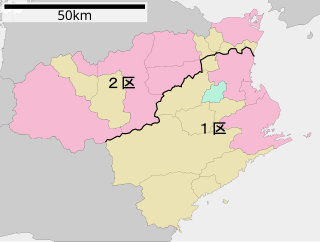
Tokushima 1st district (徳島県第1区) is a constituency of the House of Representatives in the Diet of Japan, located in Tokushima Prefecture on the island of Shikoku.

Gunma 1st District is a single-member constituency of the Japanese House of Representatives, the lower house of the National Diet. It is located in Gunma Prefecture and consists of the cities of Maebashi and Numata and the district of Tone as well as parts of the cities of Kiryū, Shibukawa and Midori. As of 2012, 387,120 eligible voters were registered in the district.

Gunma 5th district is a constituency of the House of Representatives in the Diet of Japan. It is located in Gunma Prefecture and consists of the cities of Tomioka, Annaka, parts of Takasaki and Shibukawa as well as the Kitagunma, Kanra and Agatsuma districts. As of 2012, 315,747 eligible voters were registered in the district.

Gunma At-Large District is a constituency of the House of Councillors in the Diet of Japan. It consists of Gunma Prefecture and elects two Councillors, one per election.
Saga 1st district is a constituency of the House of Representatives in the Diet of Japan. It is located in Saga Prefecture and consists of Tosu, parts of Saga and Kanzaki as well as the Miyaki District. As of September 2012, 237,748 eligible voters were registered in the district.
Wakayama 3rd district is a constituency of the House of Representatives in the Diet of Japan. It is located in Wakayama Prefecture and consists of Arida, Gobo, Shingu, and Tanabe cities and the Arida, Hidaka, Higashimuro, and Nishimuro districts. As of 2012, 298,296 eligible voters were registered in the district.
Yamaguchi's 2nd district was a constituency of the House of Representatives in the Imperial Diet of Japan. Between 1928 and 1942 it elected five representatives by single non-transferable vote (SNTV). It consisted of Yamaguchi Prefecture's Ōshima, Kuga, Kumage, Tsuno, Saba, and Yoshiki districts.
Tokyo's 1st district was a constituency of the House of Representatives in the Diet of Japan. Between 1947 and 1993 it elected four, later three representatives by single non-transferable vote. It initially consisted of Tokyo's Chiyoda, Chūō, Minato, Shinjuku, Bunkyō and Taitō special wards. In the 1964 redistricting Chūō, Bunkyō and Taitō were split off to form the new 8th district.

Aichi 5th district is a constituency of the House of Representatives in the Diet of Japan. It is located in Aichi Prefecture and consists of Nagoya's Nakamura and Nakagawa wards and the city of Kiyosu. As of 2016, 428,423 eligible voters were registered in the district.
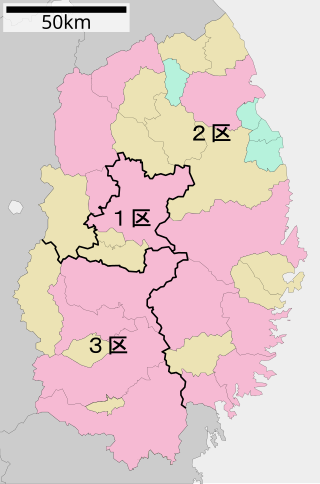
Iwate 4th district was a constituency of the House of Representatives in the Diet of Japan. It was located in southwestern Iwate and consisted of the cities of Hanamaki, Kitakami and Ōshū as well as the Waga and Isawa Districts. As of 2012, 305,917 eligible voters were registered in the district.
Tokyo 8th district was a constituency of the House of Representatives in the Diet of Japan. Between 1967 and 1993 it elected three, later two representatives by single non-transferable vote. It was created in a 1964 redistricting form areas that had previously formed part of the 1st district: It consisted of Eastern Tokyo's Chūō, Bunkyō and Taitō special wards, central parts of the former city of Tokyo. In a reapportionment for the 1993 election the number of representatives for Tokyo 8th district was reduced from three to two. Following the 1994 electoral reform, the area now forms the single-member Tokyo 2nd district.

Chiba 4th district is a constituency of the House of Representatives in the Diet of Japan. It is located in the city of Funabashi in Western Chiba. As of 2016, 459,431 eligible voters were registered in the district. In the 2009 and 2012 general elections, the district had the lowest electoral weight throughout Japan at more than two times as many voters as the district with the highest electoral weight, Kōchi-3rd.
Nagasaki 1st district is a constituency of the House of Representatives in the Diet of Japan. It is located in Southwestern Nagasaki and covers the city of Nagasaki without the former towns of Kinkai and Sotome. As of 2009, 353,871 eligible voters were registered in the district.
Nagasaki 1st district was a constituency of the House of Representatives in the Diet of Japan. Between 1947 and 1993 it elected five Representatives by single non-transferable vote. It was located in Nagasaki and, as of 1993, consisted of the cities of Nagasaki, Isahaya and Shimabara and the Nishisonogi, Kitatakaki, Minamitakaki, Kamiagata and Shimoagata counties.
Hiroshima 7th District is a constituency of the House of Representatives in the Diet of Japan. It is located in Hiroshima and consists of the city of Fukuyama. As of 2012, 377,672 eligible voters were registered in the district.
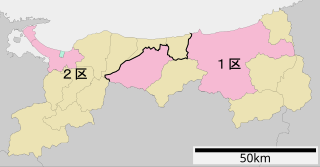
Tottori 1st district is a constituency of the House of Representatives in the Diet of Japan.
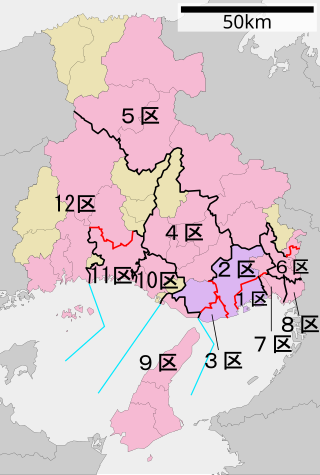
Hyogo 11th district is a constituency of the House of Representatives in the Diet of Japan. It is located in Southwestern Hyōgo and is based on the 1995 borders of the city of Himeji; the former towns of Ieshima, Yumesaki, Kōdera and Yasutomi that merged into Himeji in 2006 are part of the 12th district. As of September 2015, 387,509 eligible voters were registered in the district.
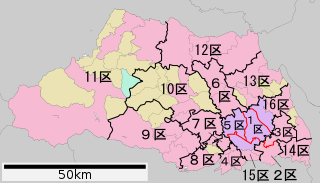
Saitama 3rd district is a constituency of the House of Representatives in the Diet of Japan. It is located in Southeastern Saitama and consists of the cities of Kawaguchi and Koshigaya. As of 2012, 460,884 eligible voters were registered in the district.

Ibaraki 4th district is a single-member constituency of the House of Representatives in the Diet of Japan. It is located in Northern Ibaraki and consists of the cities of Hitachinaka, Hitachiōta, Hitachiōmiya and Naka and the town of Daigo. As of 2021, 268,147 eligible voters were registered in the district.

Gunma 4th district is a single-member constituency of the House of Representatives in the Diet of Japan. It is located in Southern Gunma and consists of the city of Fujioka, the Southern part of Takasaki city as well as Kanna town and Ueno village in Tano county. As of 2009, 292,356 eligible voters were registered in the district.
References
- ↑ 衆議院>第23回衆議院議員選挙>群馬県>群馬3区. ザ・選挙 (in Japanese). JANJAN. Archived from the original on 9 March 2007. Retrieved 30 December 2009.
- ↑ 衆議院>第24回衆議院議員選挙>群馬県>群馬3区. ザ・選挙 (in Japanese). JANJAN . Retrieved 30 December 2009.[ dead link ]
- ↑ 衆議院>第25回衆議院議員選挙>群馬県>群馬3区. ザ・選挙 (in Japanese). JANJAN . Retrieved 30 December 2009.[ dead link ]
- ↑ 衆議院>第26回衆議院議員選挙>群馬県>群馬3区. ザ・選挙 (in Japanese). JANJAN . Retrieved 30 December 2009.[ dead link ]
- ↑ 衆議院>第27回衆議院議員選挙>群馬県>群馬3区. ザ・選挙 (in Japanese). JANJAN . Retrieved 30 December 2009.[ dead link ]
- ↑ 衆議院>第28回衆議院議員選挙>群馬県>群馬3区. ザ・選挙 (in Japanese). JANJAN. Archived from the original on 9 March 2007. Retrieved 30 December 2009.
- ↑ 衆議院>第29回衆議院議員選挙>群馬県>群馬3区. ザ・選挙 (in Japanese). JANJAN. Archived from the original on 2 March 2007. Retrieved 30 December 2009.
- ↑ 衆議院>第30回衆議院議員選挙>群馬県>群馬3区. ザ・選挙 (in Japanese). JANJAN . Retrieved 30 December 2009.[ dead link ]
- ↑ 衆議院>第31回衆議院議員選挙>群馬県>群馬3区. ザ・選挙 (in Japanese). JANJAN . Retrieved 30 December 2009.[ dead link ]
- ↑ 衆議院>第32回衆議院議員選挙>群馬県>群馬3区. ザ・選挙 (in Japanese). JANJAN. Archived from the original on 29 July 2007. Retrieved 30 December 2009.
- ↑ 衆議院>第33回衆議院議員選挙>群馬県>群馬3区. ザ・選挙 (in Japanese). JANJAN . Retrieved 30 December 2009.[ dead link ]
- ↑ 衆議院>第34回衆議院議員選挙>群馬県>群馬3区. ザ・選挙 (in Japanese). JANJAN . Retrieved 30 December 2009.[ dead link ]
- ↑ 衆議院>第35回衆議院議員選挙>群馬県>群馬3区. ザ・選挙 (in Japanese). JANJAN. Archived from the original on 29 July 2007. Retrieved 30 December 2009.
- ↑ 衆議院>第36回衆議院議員選挙>群馬県>群馬3区. ザ・選挙 (in Japanese). JANJAN . Retrieved 30 December 2009.[ dead link ]
- ↑ 衆議院>第37回衆議院議員選挙>群馬県>群馬3区. ザ・選挙 (in Japanese). JANJAN. Archived from the original on 16 March 2008. Retrieved 30 December 2009.
- ↑ 衆議院>第38回衆議院議員選挙>群馬県>群馬3区. ザ・選挙 (in Japanese). JANJAN. Archived from the original on 16 March 2008. Retrieved 30 December 2009.
- ↑ 衆議院>第39回衆議院議員選挙>群馬県>群馬3区. ザ・選挙 (in Japanese). JANJAN . Retrieved 30 December 2009.[ dead link ]
- ↑ 衆議院>第40回衆議院議員選挙>群馬県>群馬3区. ザ・選挙 (in Japanese). JANJAN . Retrieved 30 December 2009.[ dead link ]